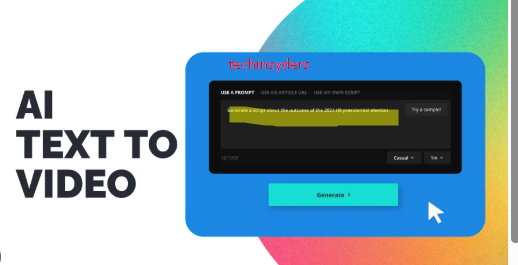Step 1: Understanding Your Target Audience
Before generating a prompt or writing the blog post, you need to have a clear understanding of your audience. Ask yourself:
- Who is this content for? (e.g., marketers, video creators, educators)
- What is the purpose of the content? (e.g., educational, entertaining, promotional)
- What value will your audience gain from this content?
Having a well-defined audience will help you craft more focused prompts for the AI tool.
Step 2: Creating a Video AI Prompt
A prompt is essentially the input you give to the AI tool to generate a video. To create an effective prompt, follow these steps:
A. Structure of a Good Prompt
- Be Specific: Clearly define the goal of the video and its intended audience.
- Provide Context: Include details such as tone, style, or key elements you want in the video.
- Use Keywords: Include keywords that the AI can use to focus the video.
- Limit Ambiguity: Avoid vague instructions—be as clear as possible.
B. Example Prompts
Here are some examples of prompts for video AI tools:
- Educational Video Prompt:
“Create a 2-minute video explaining how to grow an online business using social media marketing. Use a professional tone, include animated visuals, and target beginners with easy-to-understand language.” - Promotional Video Prompt:
“Generate a 60-second promotional video for a new AI-powered video editing tool. Highlight features like automated editing, text-to-video capabilities, and real-time editing. Use an enthusiastic and energetic tone.”
- Explainer Video Prompt:
“Produce a 3-minute explainer video about the importance of adopting renewable energy. Include statistics, engaging visuals, and a persuasive tone aimed at environmentally-conscious individuals.”
Customize your prompt based on your objectives and the type of video you want the AI to generate.
Step 3: Expanding the Prompt into a 2000-Word Blog Post
Once you’ve generated the video using the AI tool, you can use its content as the foundation for your blog post. Here’s how to organize and expand the content:
A. Blog Post Outline
- Introduction (200-300 Words):
- Introduce the topic and explain its relevance to your audience.
- Mention how AI tools can help in creating engaging video content.
- What Are Video AI Tools? (250-300 Words):
- Define video AI tools and explain how they work.
- Highlight their benefits, such as speed, cost-effectiveness, and creativity.
- How to Generate Effective Prompts for Video AI Tools (400-500 Words):
- Discuss the importance of crafting clear and actionable prompts.
- Provide a detailed guide on how to create effective prompts (refer to Step 2 above).
- Include examples of good vs. bad prompts.
- How Video AI Tools Improve Content Creation (400-500 Words):
- Explore how video AI tools streamline the content creation process.
- Share real-world examples or case studies (if available).
- Discuss how businesses and individuals can use these tools for marketing, education, and entertainment.
- Challenges and Limitations of Video AI Tools (300-400 Words):
- Highlight potential challenges, such as lack of originality or limited customization.
- Offer tips to overcome these challenges.
- Conclusion (200-300 Words):
- Summarize the value of video AI tools and the importance of crafting clear prompts.
- Encourage readers to experiment with video AI tools for their content needs.
B. Writing Tips
- Use Subheadings: Break your content into easily digestible sections.
- Include Keywords: If you’re targeting SEO, make sure to include relevant keywords like “AI video tools,” “video content creation,” and “AI-generated videos.”
- Incorporate Visuals: Add screenshots, diagrams, or examples of AI-generated videos to make your blog post more engaging.
- Provide Examples: Use real-life or hypothetical examples to illustrate your points.
Step 4: Editing and Proofreading
After writing the blog post, review it for:
- Clarity: Ensure the content is easy to read and understand.
- Grammar and Spelling: Fix any errors.
- Consistency: Maintain a consistent tone and style throughout.
You can use tools like Grammarly or Hemingway to polish your content.
Example Blog Post (Snippet)
Here’s a short snippet of how the blog post might look:
How to Generate Effective Prompts for Video AI Tools
Video AI tools are revolutionizing the way we create content, but their effectiveness depends heavily on the quality of the prompts you provide. A good prompt acts as a blueprint, guiding the AI to produce a video that matches your vision. Let’s break down the key elements of an effective prompt.1. Be Clear and Specific
When crafting your prompt, avoid vague instructions. For example:
- Bad Prompt: “Make a video about marketing.”
- Good Prompt: “Create a 90-second video for small business owners about the benefits of using social media marketing. Use animated visuals and a friendly tone.”
The second prompt provides much more detail, giving the AI clear instructions to work with.2. Include Keywords and Details
Keywords help the AI focus on the main topic, while specific details guide the tone and style. For instance:
- Keywords: Small business, social media marketing
- Details: Animated visuals, friendly tone, 90 seconds
By combining these elements, you can ensure the AI generates a video that aligns with your goals.
Conclusion
Generating a prompt for a video AI tool and turning it into a 2000-word blog post may seem like a challenge, but by following the steps outlined above, you can create engaging, high-quality content. Start by understanding your audience, craft a clear and specific prompt, and then expand on the generated video content to write a detailed blog post. With the help of AI tools, the possibilities for content creation are endless!
